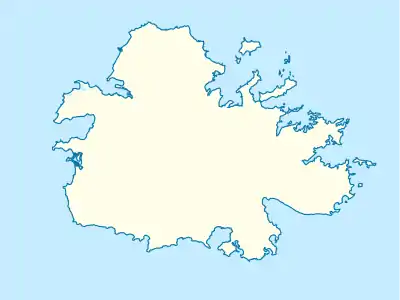| Fort Barrington | |
|---|---|
| St. John's, Antigua | |
.jpg.webp) Remains of Fort Barrington on Goat Hill (left), with cruise ship passing behind it | |
 Fort Barrington  Fort Barrington | |
| Coordinates | 17°07′47″N 61°53′11″W / 17.129853°N 61.886257°W |
| Type | Fortification |
| Site information | |
| Open to the public | Yes |
| Condition | Ruins |
| Site history | |
| Built | 1779 |
| In use | No |
| Materials | Stone |
Fort Barrington (previously Goat Hill Fort, Cripplegate Battery, and Queen’s Battery) is a historic military fort in Antigua and Barbuda. It is located on Goat Hill in St. John's, Antigua, at the western entrance to St. John's Harbor.[1][2] The fort was built in 1779, and was named for Admiral Samuel Barrington.[3] Remains of the fort include a circular battery, small magazine, and barracks.[4]
History
In the 17th century, the British built a battery on Goat Hill in St. John's.[5][1] Sitting at the most southwestern point of St. John's Harbor, the battery's location was ideal for protecting the harbor's entrance as well as the anchorage outside the harbor.[1] The battery was attacked multiple times, and in the 18th century it was often described as being in disrepair.[6] It was abandoned after Queen Anne’s War.[1]
In 1779, a new fort was built at the location of the previous battery.[1][4] Its purpose was to assist Fort James (located at the harbor's opposite entrance) with protecting St. John's Harbor.[1] The fort was completed under the administration of General William Mathew Burt,[7] who was governor of the Leeward Islands from 1776 to 1781. It served as a major fortification for the British during the American Revolutionary War and the War of 1812.
The fort's previous names were Goat Hill Fort,[7][8] Cripplegate Battery,[5][6] and Queen’s Battery.[5][2] It was renamed Fort Barrington for the British royal navy admiral Samuel Barrington.[1][5] Barrington was commander in chief of the Leeward Islands station during the time of the fort's construction.[9]
References
- 1 2 3 4 5 6 7 "Historical Sites: Forts". www.nationalparksantigua.com. Antigua & Barbuda National Park. Archived from the original on 2023-01-31. Retrieved 2023-09-20.
- 1 2 The United Service Magazine and Naval and Military Journal. Henry Colburn. 1842.
- ↑ Buisseret, David (1970). "A Brief Assessment of the Chief Military Monuments of: Grenada, Saint Vincent, Saint Lucia, Antigua". Caribbean Quarterly. 16 (1): 58–67. doi:10.1080/00086495.1970.11829040. ISSN 0008-6495. JSTOR 40653135.
- 1 2 Clements, Bill (2019-04-30). Britain's Island Fortresses: Defence of the Empire 1756–1956. Pen and Sword. ISBN 978-1-5267-4031-1.
- 1 2 3 4 Waters, Christopher (December 2018). Putting Forts in their Place: The Politics of Defense in Antigua, 1670-1785 (Thesis). S2CID 195487452.
- 1 2 DeCorse, Christopher (2019-04-01). Power, Political Economy, and Historical Landscapes of the Modern World: Interdisciplinary Perspectives. SUNY Press. ISBN 978-1-4384-7343-7.
- 1 2 Antigua and the Antiguans: a Full Account of the Colony and Its Inhabitants from the Time of the Caribs to the Present Day, Interspersed with Anecdotes and Legends. Saunders and Otley. 1844.
- ↑ The West Indies. Book 1: The Leeward and Windward Islands and Trinidad. S. W. Silver & Co. 1880.
- ↑ West Jr., Richard S. (September 1942). "Barrington On The Leeward Station". Proceedings. U.S. Naval Institute. Retrieved 2023-09-20.
.svg.png.webp)